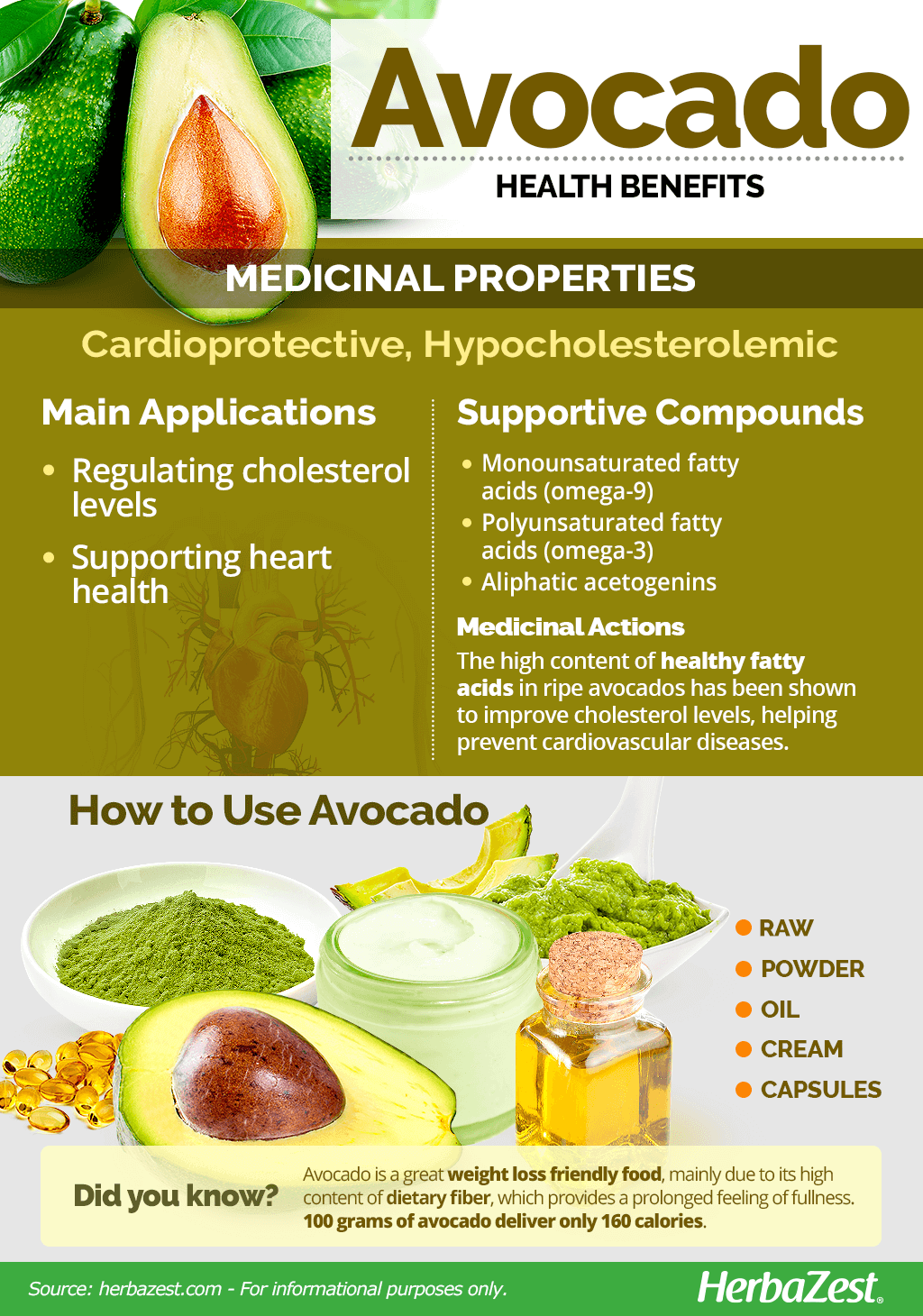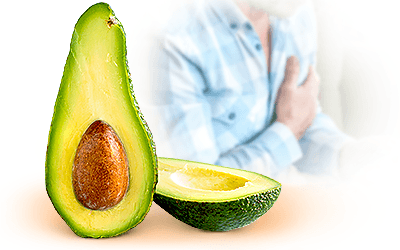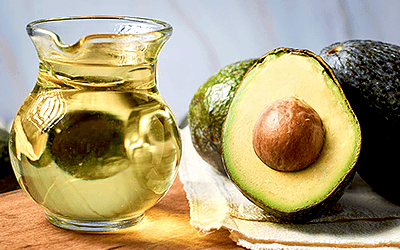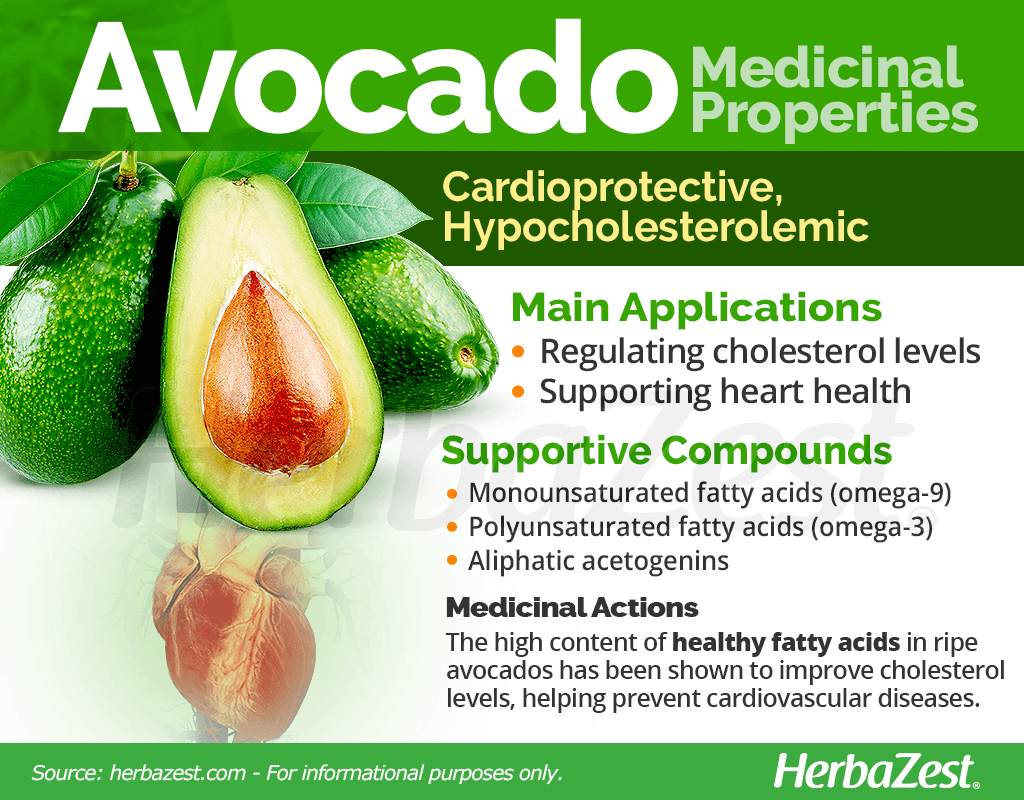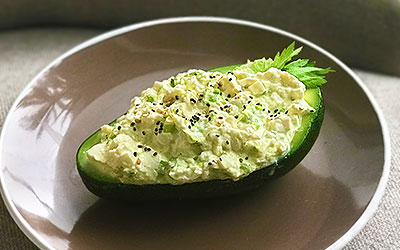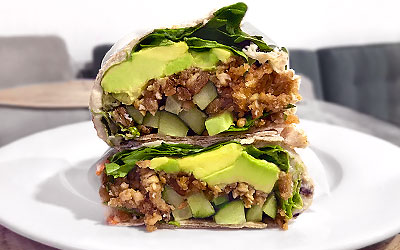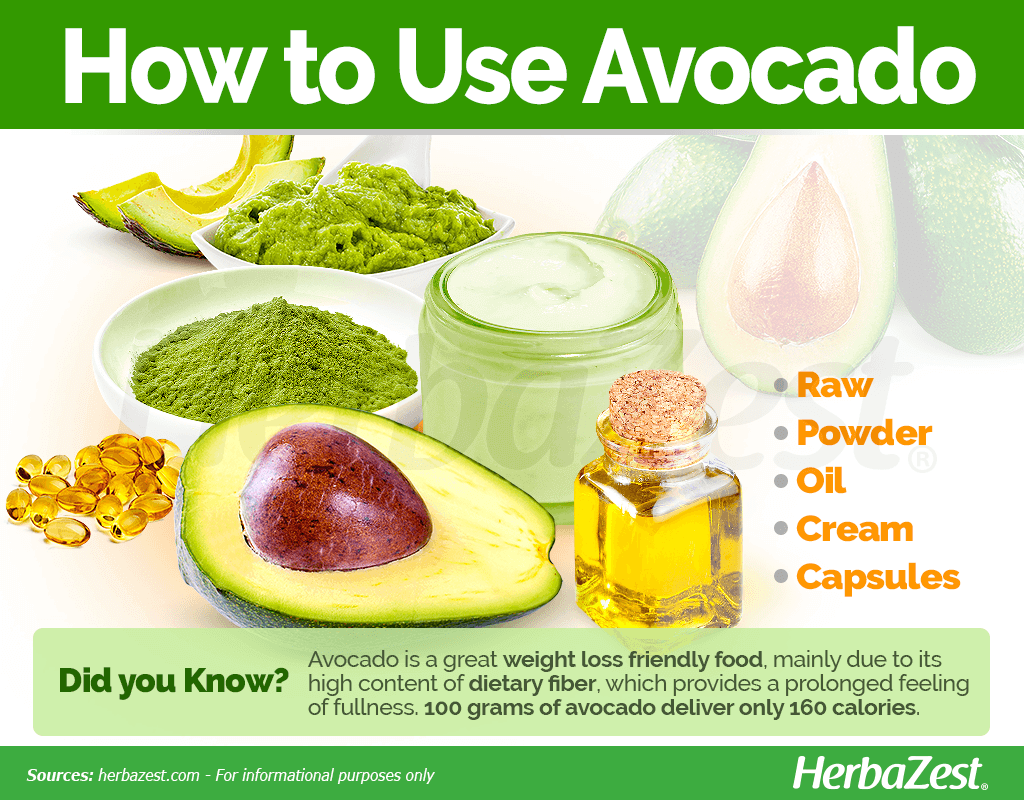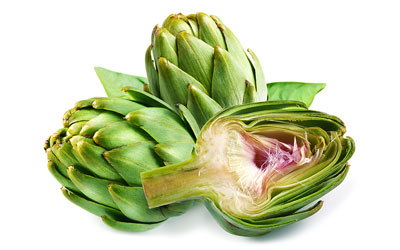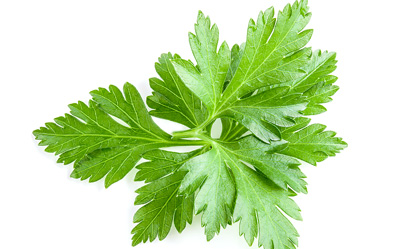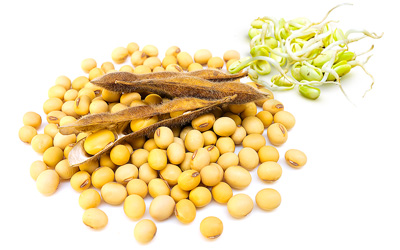Avocado, a fruit originally from Mexico, has been one of the most popular natural foods for centuries. Researchers believe it may have been first cultivated as a food crop in South America after being transported from Mexico around 10,000 BCE. By 900 AD, the avocado was being cultivated in Central and South America, where it was mostly prized for its culinary value and its alleged aphrodisiac properties. Modern science has revealed the tangible benefits of avocado, which are now enjoyed around the world.
Avocado Medicinal Properties
- Medicinal action Cardioprotective, Hypocholesterolemic
- Key constituents Omega-9, omega-3, aliphatic acetogenins
- Ways to use Capsules, Food, Ointment
- Medicinal rating (3) Reasonably useful plant
- Safety ranking Safe
Health Benefits of Avocado
The complex actions of the nutrients in avocado bring a variety of health benefits. Avocados has been shown to contribute with:
Regulating cholesterol levels. The healthy fats in avocados have been shown to be effective for reducing LDL, or "bad" cholesterol.
Supporting heart health. Avocado consumption has been linked to a reduced risk of cardiovascular diseases.
In addition, avocado can help fight other conditions, such as:
Reducing inflammation. Scientific studies has shown that consuming avocados can help ease the inflammatory pain caused by arthritis and osteoporosis.
Lowering blood sugar levels. Avocados have hypoglycemic properties, which help reduce glucose levels, thus contributing to avoid sugar spikes after meals. For this reason, avocados are ideal for people with hyperglycemia and diabetes.
Soothing damaged skin. The healthy oils in avocado act as natural skin moisturizers when applied topically.
How It Works
The main compounds in avocado are healthy fats, mainly omega-9, or oleic acid, which is a mononsaturated fatty acid and makes up to 70% of the ripe fruit (depending on the variety), and omega-3 (a polyunsaturated fatty acid) in lower proportions.
The high monounsaturated fatty acid content in ripe avocados has been shown to improve lipid profile in both healthy individuals and patients with mildly elevated cholesterol levels, even when combined with high triglycerides, which contributes to prevent cardiovascular diseases.1,2
In addition, aliphatic acetogenins, which are phytonutrients exclusive to the avocado fruit, have been shown to have antibacterial and anti-inflammatory properties.
Regular avocado consumption has been linked to improvements in skin elasticity and firmness.3
Olive oil and sacha inchi seeds also possess cardioprotective properties, and similar anti-inflammatory benefits can be found in herbs like turmeric and cherry.
Avocado Side Effects
Avocado is likely safe for most people when taken in its food form, although it is possible for some individuals to have an allergic reaction when consuming avocados. In its medicinal form it is possibly safe, even when taken in the long term. However, it may cause mild skin irritation when applied topically if there is a potential allergy or sensitivity to avocados.
Cautions
While it is not common, those who suffer from a latex allergy may potentially suffer from an avocado allergic reaction. For this reason, those who suffer from latex allergies should limit their intake of avocados until they know how it will affect them.
Women who are pregnant or breastfeeding should limit their avocado intake to its food form rather than its medicinal forms. However, consuming avocados is likely safe due to its high monounsaturated fatty acid content.
Avocado Nutrition
The full nutritional value of avocados is rounded up by copious amounts of vitamins B5 (pantothenic acid), B6 (pyridoxine), B9 (folate), C (ascorbic acid), E (tocopherol), and K, as well as minerals such as potassium, phosphorus, zinc, and magnesium.
The avocado fruit also provide very small amounts of minerals, such us calcium, iron, as well as vitamins A (as carotenoids), B1 (thiamin), B2 (riboflavin), and B3 (niacin).
In spite of their high fatty content, avocados are a great weight loss friendly food. This is due to their high content of dietary fiber, which provides a prolonged feeling of fullness, thus reducing food cravings between meals.
100 grams of avocado provide 160 calories and 27% of the daily value for dietary fiber.
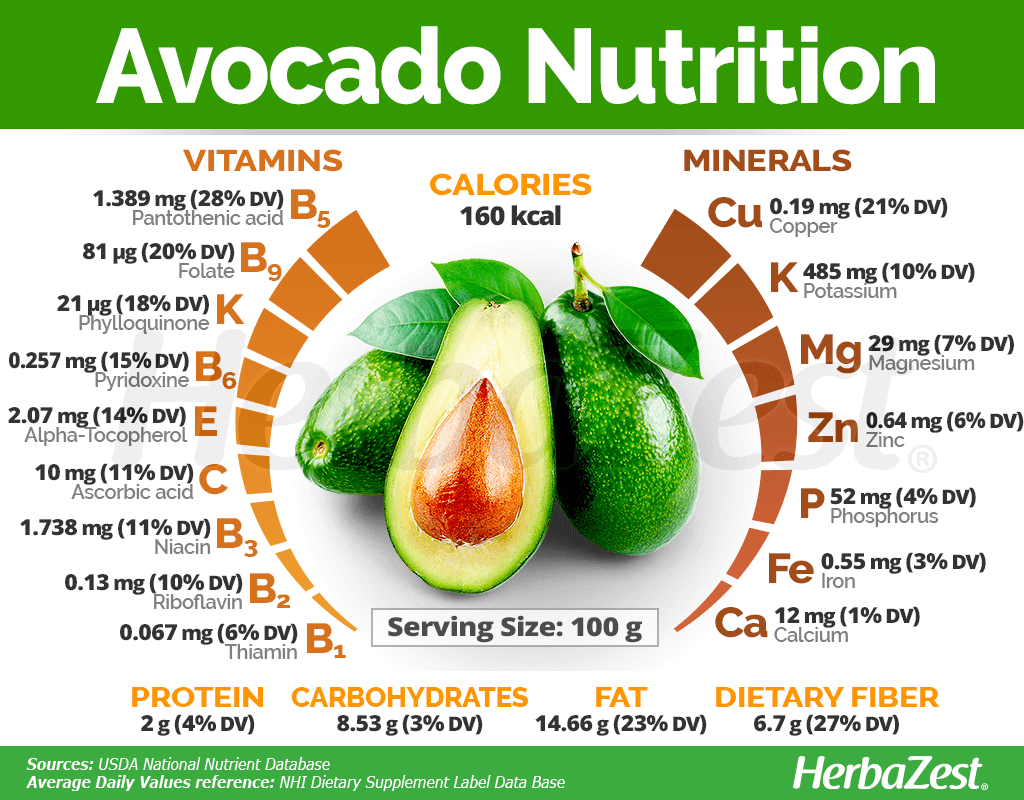
How to Consume Avocado
- Edible parts Fruit
- Edible uses Oil
While there are three main medicinal forms of avocado, the most beneficial means of consuming avocados is in its concentrated capsule form. However, depending on the ailment, consuming avocado is advantageous in all of its states.
Natural Forms
Raw. Eating raw avocado can regulate cholesterol levels and soothe joint inflammation. Whether it is sliced or crushed, avocado can also be combined with other foods to increase its nutritional value.
Powder. After being dehydrated and finely ground, the avocado seed can add nutritional value to juices and smoothies. It also can help regulate blood sugar, reduce inflammation, and aid with constipation.
Herbal Remedies & Supplements
Oil. Rich in vitamin E and oleic acid, avocado oil is obtained from the seed of the fruit. It moisturizes the skin and promotes hair's health. Additionally, it has a very high smoke point (520°F or 271°C), which makes it great for culinary uses.
Cream. When applied topically, avocado creams are highly useful soothing irritated skin.
Capsules. Avocado oil capsules contain high amounts of monounsaturated fatty acids, which are beneficial for regulating cholesterol levels, as well as for reducing joint pain.
Growing
- Life cycle Perennial
- Harvested parts Fruit
- Light requirements Partial shade
- Soil Loamy sand
- Soil pH 6.1 – 6.5 (Slightly acidic)
- Growing habitat Subtropical regions
- USDA Plant Hardiness Zones 0a, 9a, 9b, 10a, 10b, 11a, 11b
- Plant spacing average 7 m (22.97 ft)
- Potential diseases Phytophthora spp.
Like with many tropical plants, avocados need special care in order to thrive, especially for irrigation. Follow the guidelines below in order to grow an avocado tree:
Growing Guidelines
Avocado trees tend to grow best planted in loamy sand soils with a pH of 6.0 - 6.5 and a large quantity of coarse organic matter.
Although their resistance to cold will depend upon the variety, as a general rule, they require a temperature always above 32°F (0°C) in order to survive.
When irrigating, it is advisable to soak the root system well and let the surface dry before irrigating again.
A balanced mix of nitrogen, phosphorus, and potassium should be used to fertilize the avocado tree. It can be advantageous to add zinc to this mix, too.
More detailed information about growing avocado can be found in the herb garden section.
Additional Information
- Other uses Cosmetics
Plant Biology
Avocado is an evergreen perennial fruit tree, typical of subtropical climates. It possesses a pear-shaped fruit with an immense nutritional value, which has led to its extensive cultivation and crossbreeding. The avocado tree can grow up to 66 feet (20 m) tall and can be recognized by its 5 - 10 inch (12 - 25 cm) long leaves and greenish-yellow flowers. The edible part of the tree, the avocado fruit possesses a single large seed, and can range from 3 - 8 inches (7 - 20 cm) long.
Classification
Avocado is a member of the Lauraceae family, which comprises 2000 species across 50 genera, and it is characterized by flowering trees and shrubs, many of them aromatic, such as bay laurel and cinnamon. Avocado (Persea americana) is one of the around 70 species in the Persea genus that are exclusively from the New World.
Varieties and Subspecies of Avocado
The avocado tree is only partially self-pollinating, which has favored the development of different varieties and cultivars through selective breeding. There are well over 20 varieties of avocado cultivated around the world nowadays, although they all belong to the Mexican, Guatemalan, or West Indian types, depending on their origin.
In addition, cultivars have been developed to enhance certain aspects of the fruit or the plant's hardiness against cold or pests. The most important cultivars include 'Hass', 'Fuerte', 'Pinkerton', 'Lula', and 'Choquette' avocados. Cultivars that belong to the Mexican type are currently the most widely cultivated worldwide, accounting for approximately 80% of global yield.
Historical Information
Avocados found their way to Europe after the Spanish Conquest, in the early 16th century. They were introduced to South Africa and Australia 300 years later, and nowadays they are popular around the world.
Economic Data
Mexico remains the number-one provider of avocados, producing over 1 million metric tons every year. Indonesia takes second place, and the U.S. third. Demand sometimes outstrips supply due to avocados being a seasonal plant. Many South American countries provide avocado during the off-season, allowing a strong avocado industry to thrive.
Popular Beliefs
Avocados, native to central Mexico, held great significance for the ancient Aztecs. The name avocado came from the Aztec word ahuácatl, which means testicle. While the name is in reference to the fruit's shape, it was considered a powerful aphrodisiac for the Aztecs, leading the men to keep their daughters inside during the avocado growing season for protection.
Other Uses of Avocado
Cosmetics. Because of its healthy oil and creamy texture, as well as its pretty green color and refreshing scent, the avocado pulp makes a great moisturizer agent, used in many personal care products.
Sources
- Allergy Proceedings, Prevalence of avocado allergy among atopic patients, 1995
- Archives in Medicinal Research, Monounsaturated fatty acid (avocado) rich diet for mild hypercholesterolemia, 1996
- The Encyclopedia of Fruits and Nuts, p. 440
- The Journal of Nutrition, Defatted avocado pulp reduces body weight and total hepatic fat but increases plasma cholesterol in male rats fed diets with cholesterol, 2002
- USDA Plants Database
- Encyclopedia of Herbal Medicine, p. 122
- Journal of Food Science, Heat-induced off-flavor in avocado flesh, 1970
Footnotes:
- Journal of Nutrition. (2020). A Moderate-Fat Diet with One Avocado per Day Increases Plasma Antioxidants and Decreases the Oxidation of Small, Dense LDL in Adults with Overweight and Obesity: A Randomized Controlled Trial. Retrieved November 22, 2022 from: https://www.ncbi.nlm.nih.gov/pmc/articles/PMC7373821/
- Journal of thhe American Heart Assotiation. (2022). Avocado Consumption and Risk of Cardiovascular Disease in US Adults. Retrieved November 22, 2022 from: https://www.ncbi.nlm.nih.gov/pmc/articles/PMC9075418/
- Journal of Cosmetic Dermatology. (2022). Avocado Consumption Increased Skin Elasticity and Firmness in Women – A Pilot Study. Retrieved November 22, 2022 from: https://pubmed.ncbi.nlm.nih.gov/35037373/
